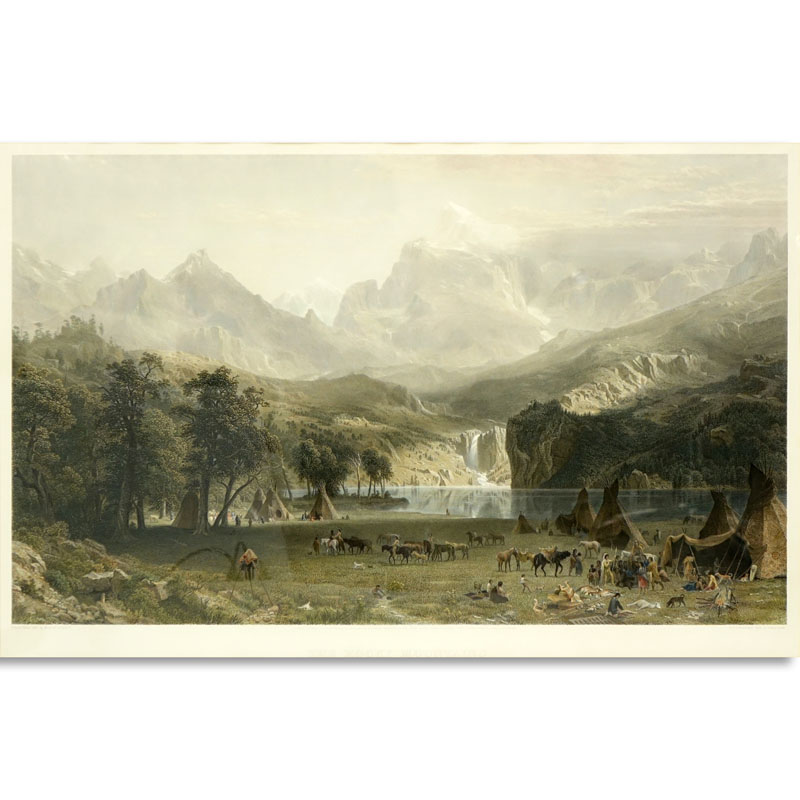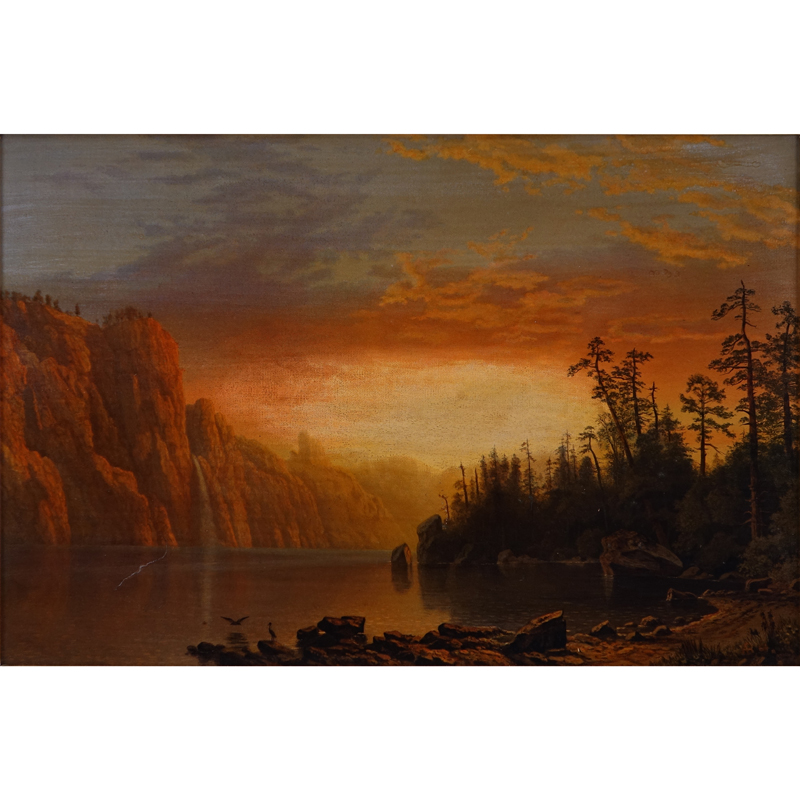Albert Bierstadt (German/American, 1830-1902) "Autumn Morning on the Banks of the Passaic River, New Jersey" oil on canvas signed lower left, titled on early 20th-century handwritten label on frame backing, "Darvish Collection Inc." label also on frame backing. Gesso and giltwood frame. 14" x 20", framed 25" x 31" Provenance: (Probably) Estate of the artist's brother, Edward Bierstadt (1824-1906), American Art Galleries, New York, New York, January 22-23, 1908, lot 230; (probably) Otto Gerdan (1852-1920), Gerdan Company, New York, New York; Private collection; Christie's East, New York, New York, September 29, 1999, lot 25; The Darvish Collection, Inc., Naples, Florida; Private collection, North Carolina. Exhibited: (Probably) American Art Galleries, New York, New York, January 22-23, 1908. Literature: American Art Directory, vol. 6. (New York: American Federation of Arts/R.R. Bowker & Co., 1908), pp. iv, 98-100. A landscape titled "Passaic River" that matches the medium and dimensions of this painting is listed in this text/directory under works offered at sale from the Estate of Edward Bierstadt the artist's brother. Notes: Albert Bierstadt a native of Germany, who emigrated to the United States at a young age with his family, was the most famous and financially successful American Romantic landscape painter of his time. He exhibited annually at the National Academy of Design in New York, and was an advocate of the Hudson River School's study of outdoor atmospheric lighting. In the 1860s and 1870s, his works earned the highest prices achieved by an American artist. U.S. Congress even allocated $20,000 for one of his paintings. His epic terrains, with dramatic and diffuse lighting, captivated the imagination of 19th-century collectors, because he depicted the rugged American mountains, coasts, frontiers and pastures through the rosy tinted lens of "romantic pantheism." For Bierstadt, the landscape was a sublime experience; it was a reflection of God's creation, and it was a medium for spiritual transcendence that both sanctioned and abated manifest destiny. Though well known for his monumental scenes of the Rocky Mountains and Western frontier, Bierstadt also produced an impressive body of smaller, intimate landscapes of the northeastern United States, which equally attract collectors through their command of soft ethereal lighting. This plein-air study of the Passaic River is another vignette in the annals of this master narrative; it is a tour-de-force of luminist lighting, deftly conveyed through a cool autumn morning in which the mist subtly lifts from the water, and obfuscates all the brushstrokes like a veritable wash, blending the colors and tones into hazy forms that convey the reflective tranquility of their setting.
Albert Bierstadt (German/American, 1830-1902) "Autumn Morning on the Banks of the Passaic River, New Jersey" oil on canvas signed lower left, titled on early 20th-century handwritten label on frame backing, "Darvish Collection Inc." label also on frame backing. Gesso and giltwood frame. 14" x 20", framed 25" x 31" Provenance: (Probably) Estate of the artist's brother, Edward Bierstadt (1824-1906), American Art Galleries, New York, New York, January 22-23, 1908, lot 230; (probably) Otto Gerdan (1852-1920), Gerdan Company, New York, New York; Private collection; Christie's East, New York, New York, September 29, 1999, lot 25; The Darvish Collection, Inc., Naples, Florida; Private collection, North Carolina. Exhibited: (Probably) American Art Galleries, New York, New York, January 22-23, 1908. Literature: American Art Directory, vol. 6. (New York: American Federation of Arts/R.R. Bowker & Co., 1908), pp. iv, 98-100. A landscape titled "Passaic River" that matches the medium and dimensions of this painting is listed in this text/directory under works offered at sale from the Estate of Edward Bierstadt the artist's brother. Notes: Albert Bierstadt a native of Germany, who emigrated to the United States at a young age with his family, was the most famous and financially successful American Romantic landscape painter of his time. He exhibited annually at the National Academy of Design in New York, and was an advocate of the Hudson River School's study of outdoor atmospheric lighting. In the 1860s and 1870s, his works earned the highest prices achieved by an American artist. U.S. Congress even allocated $20,000 for one of his paintings. His epic terrains, with dramatic and diffuse lighting, captivated the imagination of 19th-century collectors, because he depicted the rugged American mountains, coasts, frontiers and pastures through the rosy tinted lens of "romantic pantheism." For Bierstadt, the landscape was a sublime experience; it was a reflection of God's creation, and it was a medium for spiritual transcendence that both sanctioned and abated manifest destiny. Though well known for his monumental scenes of the Rocky Mountains and Western frontier, Bierstadt also produced an impressive body of smaller, intimate landscapes of the northeastern United States, which equally attract collectors through their command of soft ethereal lighting. This plein-air study of the Passaic River is another vignette in the annals of this master narrative; it is a tour-de-force of luminist lighting, deftly conveyed through a cool autumn morning in which the mist subtly lifts from the water, and obfuscates all the brushstrokes like a veritable wash, blending the colors and tones into hazy forms that convey the reflective tranquility of their setting.















Testen Sie LotSearch und seine Premium-Features 7 Tage - ohne Kosten!
Lassen Sie sich automatisch über neue Objekte in kommenden Auktionen benachrichtigen.
Suchauftrag anlegen